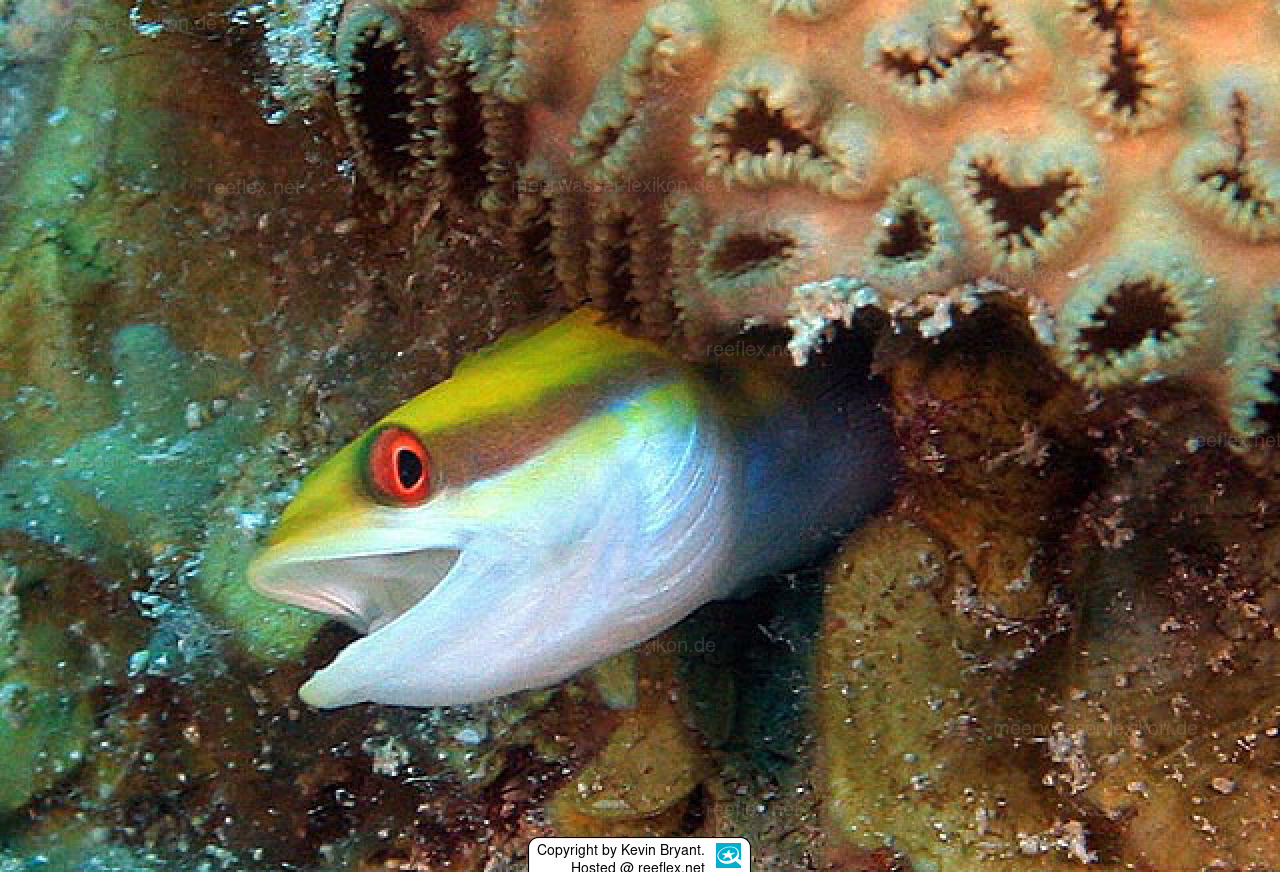Info
Longley & Hildebrand, 1940
This Wrasse blenny lives in holes in coral and rock, but leaves burrow to swim freely in water column.
The wrasse mimics the bluehead, Thalassoma bifasciatum (Bloch, 1791) , in order to get close to small fish and shrimps on which it preys.
Source: FishBase
Elongate; head elongate, pointed, not spiny on top; no cirri on nostrils, eyes or nape; jaws long, lower jaw projecting; top lips on sides of jaws and across front; tip of lower jaw without a pointed fleshy projection; 1 row of teeth on each side of roof of mouth; jaws with an outer row of large, curved teeth and an inner row of small teeth; dorsal fin XXI-XXIII, 17, a slight notch between spines and rays; pelvics I (internal), 2-3, inserted before pectoral base; all fin rays unbranched; no lateral line; no scales.
Color variable: yellowish to greenish yellow above, white below, with or without a broad dark stripe (which may be solid or broken) from the snout, through the eye to tail fin base, widening to a round black spot at base of tail fin; a black spot on outer part of dorsal fin near front; a central black stripe along the center of the snout and nape and along the back at the base of the spiny dorsal fin; eye red. Juveniles: translucent, with a black stripe.
Source:
Shorefishes of the Greater Caribbean online information system
Jumping guard
A jumping guard prevents (nocturnal) fish from jumping out.
Wrasses, blennies, hawkfishs and gobies jump out of an unprotected tank in fright if their night rest is disturbed, unfortunately these jumpers are found dried up in the morning on carpets, glass edges or later behind the tank.
https://www.korallenriff.de/en/article/1925_5_Jump_Protection_Solutions_for_Fish_in_the_Aquarium__5_Net_Covers.html
A small night light also helps, as it provides the fish with a means of orientation in the dark!
Synonymised names
Hemiemblemaria simulus Longley & Hildebrand, 1940 · unaccepted
This Wrasse blenny lives in holes in coral and rock, but leaves burrow to swim freely in water column.
The wrasse mimics the bluehead, Thalassoma bifasciatum (Bloch, 1791) , in order to get close to small fish and shrimps on which it preys.
Source: FishBase
Elongate; head elongate, pointed, not spiny on top; no cirri on nostrils, eyes or nape; jaws long, lower jaw projecting; top lips on sides of jaws and across front; tip of lower jaw without a pointed fleshy projection; 1 row of teeth on each side of roof of mouth; jaws with an outer row of large, curved teeth and an inner row of small teeth; dorsal fin XXI-XXIII, 17, a slight notch between spines and rays; pelvics I (internal), 2-3, inserted before pectoral base; all fin rays unbranched; no lateral line; no scales.
Color variable: yellowish to greenish yellow above, white below, with or without a broad dark stripe (which may be solid or broken) from the snout, through the eye to tail fin base, widening to a round black spot at base of tail fin; a black spot on outer part of dorsal fin near front; a central black stripe along the center of the snout and nape and along the back at the base of the spiny dorsal fin; eye red. Juveniles: translucent, with a black stripe.
Source:
Shorefishes of the Greater Caribbean online information system
Jumping guard
A jumping guard prevents (nocturnal) fish from jumping out.
Wrasses, blennies, hawkfishs and gobies jump out of an unprotected tank in fright if their night rest is disturbed, unfortunately these jumpers are found dried up in the morning on carpets, glass edges or later behind the tank.
https://www.korallenriff.de/en/article/1925_5_Jump_Protection_Solutions_for_Fish_in_the_Aquarium__5_Net_Covers.html
A small night light also helps, as it provides the fish with a means of orientation in the dark!
Synonymised names
Hemiemblemaria simulus Longley & Hildebrand, 1940 · unaccepted







 Kevin Bryant, USA
Kevin Bryant, USA


